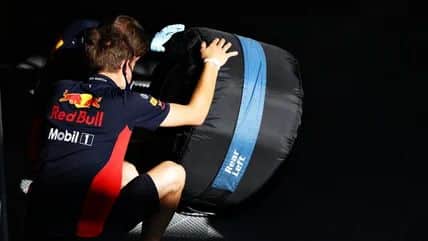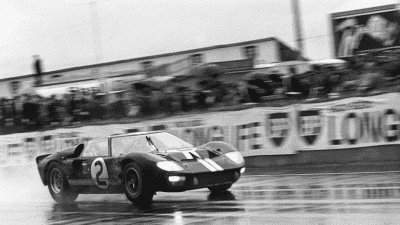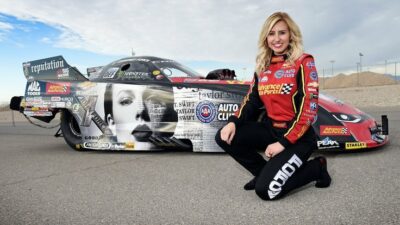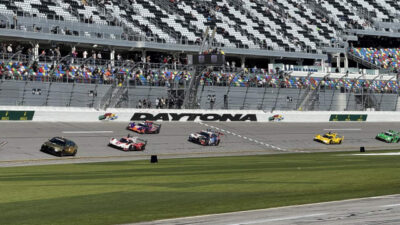Motorsport fans often focus on speed, strategy, and skill when watching their favorite races. However, behind every thrilling competition lies a complex web of regulations that can seem bizarre to outsiders. These unusual rules exist for specific reasons, from safety concerns to maintaining competitive balance, though their logic isn’t always immediately obvious.

Racing organizations have created some truly unexpected regulations over the decades. Drivers face restrictions on everything from their clothing choices to how they can interact with their vehicles during competition. These rules span across different motorsport disciplines, affecting Formula 1 drivers, NASCAR competitors, and even lawn mower racers in ways that might surprise casual observers.
1) Drivers fined for wearing incorrect underwear in Formula 1

Formula 1 has strict rules about driver underwear that many fans don’t know about. The FIA requires all drivers to wear fireproof underwear made from specific materials during races.
Drivers can actually be penalized for wearing the wrong kind of underwear, and this rule exists for important safety reasons. The underwear must meet fire-resistant standards to protect drivers in crashes.
The FIA’s International Sporting Code states that drivers need long underwear made only from materials the organization approves. Race officials check this gear during their inspection process.
This isn’t just a theoretical rule. Formula E driver Lucas di Grassi was fined in 2018 for not wearing compliant underwear. The penalty shows how seriously officials take these safety requirements.
The rule became more important after serious crashes like Romain Grosjean’s fiery accident. The FIA has tightened enforcement of underwear and jewelry rules to better protect drivers from burns.
Race directors now regularly remind teams about these underwear requirements before each race weekend.
2) Ban on using tire warmers during races
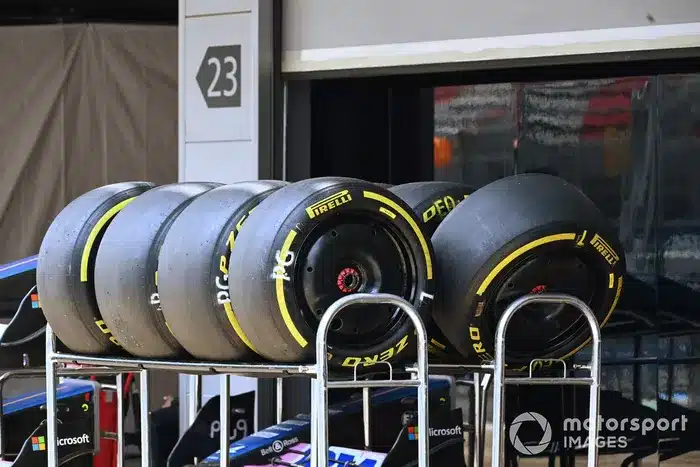
Most fans don’t realize that tire warmers are banned during actual races in many motorsport series. Teams can only use these electric blankets before the race starts or during practice sessions.
Formula 1 has tried to ban tire warmers multiple times over 15 years. Teams keep pushing back against the rule changes.
The WEC banned tire warmers to reduce energy use at race meetings. Ferrari called this decision dangerous after incidents at Spa.
GT World Challenge America introduced a tire warmer ban for the 2025 season. This means drivers must warm their tires through driving alone.
Cold tires provide much less grip than warm ones. Drivers face a dangerous period after pit stops when their fresh tires haven’t reached proper temperature yet.
Teams use tire warmers because F1 wants to reduce energy consumption at race events.
3) Mandatory groove tires instead of slicks in certain eras

Formula 1 drivers had to use grooved tires from 1998 to 2008 instead of the faster slick tires. This rule seems backwards since slick tires give maximum grip in dry conditions.
The FIA made this change to slow down the cars. Front tires had 3 grooves and rear ones had 4 grooves cut into them.
The grooves reduced the contact patch between tire and track. This meant less grip and slower cornering speeds. The grooved tires also had to be much stiffer than slicks, which further reduced performance.
Max Mosley wanted to reduce car performance after safety concerns in the 1990s. The grooved tire rule achieved this goal by making cars significantly slower through corners.
Teams worried that worn grooved tires might become effectively slick during races. This created concerns about protests and disqualifications when the grooves wore down too much.
Slick tires returned in 2009 after eleven seasons of mandatory grooves. The sport moved back to the faster, more logical tire design.
4) Disqualification for releasing oil on the track intentionally

Oil spills on racetracks create dangerous conditions for all drivers. When cars hit oil slicks, they lose traction and can crash at high speeds.
Some drivers have been accused of deliberately releasing oil to slow down competitors behind them. This creates an unfair advantage while putting other racers at serious risk.
Racing organizations take oil violations very seriously. NASCAR has specific penalties for violating oil system rules that can result in disqualification.
NHRA has also cracked down on oil-related issues. Oildowns by Top Fuel and nitro Funny Car drivers cause major delays during live television broadcasts.
The penalties for intentional oil release are harsh. Drivers can face immediate disqualification from the race and loss of points.
Racing officials monitor cars closely for oil leaks during races. They use track observers and cameras to catch violations quickly.
This rule exists to keep racing fair and safe. Oil on the track can turn a competitive race into a dangerous situation for everyone involved.
5) No refueling during races in Formula 1 since 2010

Formula 1 cars cannot refuel during races. This might seem strange to fans of other motorsports where pit stops include adding fuel.
The FIA banned refueling during races in 2010 due to safety concerns for drivers. Before this rule change, refueling was a major part of F1 strategy for many years.
Teams used to run lighter cars by carrying less fuel. This made the cars faster but required fuel stops during races.
The ban forced major changes to car design. Fuel tanks became larger to hold enough fuel for entire races. Cars now start races much heavier than before.
Drivers must manage their fuel load throughout the entire race without the option to refuel in the pits. This creates a different type of strategy challenge.
The refueling ban was considered both dangerous and expensive by racing officials. Modern F1 pit stops focus only on tire changes and repairs.
6) NASCAR’s rule requiring restrictor plates at select tracks

NASCAR only uses restrictor plates on certain tracks, not all of them. These metal plates limit engine power by reducing airflow.
The rule started after Bobby Allison’s serious crash at Daytona in 1987. NASCAR implemented restrictor plates following this wreck to improve safety.
Restrictor plates are used to limit engine power and reduce car speeds on specific tracks. This happens only at superspeedways like Daytona and Talladega.
Cars were reaching speeds over 210 miles per hour in qualifying. NASCAR introduced engine restrictions in the late 80s when these dangerous speeds became common.
Other NASCAR tracks don’t need restrictor plates because they’re smaller or have less banking. Only the biggest, fastest tracks require them.
The plates force cars to run in tight packs. This creates different racing than normal NASCAR events.
7) Rules forbidding drivers from swapping cars mid-race

Modern motorsports strictly forbid drivers from switching cars during a race. This wasn’t always the case.
In Formula 1’s early days, drivers used to share cars mid-race. The 1956 Italian Grand Prix at Monza featured legendary car swapping between teammates.
Back in the 1950s and 1960s, drivers would swap cars during races when their original vehicle broke down. This practice helped teams salvage points from mechanical failures.
Today’s rules make this impossible. Each driver must finish in the same car they started with.
NASCAR has different rules for driver changes. Teams can swap drivers mid-race, but two drivers from the same team cannot exchange cars. A Hendrick Motorsports driver cannot swap rides with their teammate.
The ban on car swapping exists for safety and fairness reasons. It prevents confusion about who drove which car and ensures proper driver identification throughout the race.
8) Lawn Mower Racing regulated with strict safety gear mandates

Lawn mower racing involves ride-on mowers with blades removed for safety. The sport is popular in both the United States and United Kingdom.
Racing organizations enforce strict safety rules for all participants. Safety regulations are vital to protect racers during competitions.
All racers must complete thorough safety training before entering the track. This training covers essential rules and safety procedures.
Protective equipment requirements vary by racing class and organization. Helmets are mandatory for all participants regardless of their racing category.
Racing associations emphasize that motorsports are dangerous and can be destructive. They warn that competitors participate at their own risk.
Safety equipment standards apply across different racing levels. Age restrictions exist for younger racers, with those 15 and under staying in classes with governed engine controls.
Racing committees reserve the right to change safety rules. These modifications focus on protecting participants and growing the sport safely.
The safety-first approach makes lawn mower racing surprisingly regulated despite its unusual nature.
9) NASCAR’s unique lap scoring involving odd and even laps

NASCAR once used a strange scoring system that tracked drivers on alternating laps. This method counted positions only on specific lap intervals rather than every single lap.
The system worked by recording driver positions on either odd-numbered or even-numbered laps. Officials would only update the official running order at these predetermined intervals.
This created confusion when drivers passed each other between the counted laps. A driver could gain several positions but not receive credit until the next scoring lap occurred.
The rule made it difficult for fans to follow the actual race standings. Television broadcasts struggled to show accurate positions in real-time.
Drivers and teams had to strategically time their moves around these scoring intervals. Some would wait until just after a scoring lap to make aggressive passes.
This unusual race scoring method has since been abandoned. Modern NASCAR uses electronic scoring that tracks every car’s position continuously throughout each race.
The old system sometimes led to disputes about final finishing positions. Officials had to review timing data carefully to determine the correct results after each race ended.
10) Ban on double yellow flags during NASCAR restarts

NASCAR has strict rules about when yellow flags can be thrown during restarts. Officials cannot call cautions immediately after the green flag waves unless there is a serious safety issue.
This rule prevents race control from throwing quick yellows for minor incidents. It forces drivers to be more careful during the crucial restart moments.
The policy exists because restarts are the most exciting part of many races. Fans want to see green flag racing without constant interruptions.
NASCAR’s yellow flag procedures have changed many times throughout the sport’s history. Each change aimed to improve racing intensity or safety.
During the restart window, drivers must sort out minor contact on their own. Only major crashes or debris will trigger an immediate caution.
This creates intense racing action right after restarts. Cars are bunched together and drivers know they have limited protection from quick yellows.
The rule applies to all NASCAR series during official restart procedures. It begins when the green flag waves and lasts for a specific number of laps or until the field spreads out.
Origins And Logic Behind Unusual Motorsport Regulations

Motorsport rules often seem bizarre to outsiders, but most stem from specific incidents or safety concerns that forced governing bodies to act quickly. These regulations developed through decades of trial and error as racing evolved from informal competitions into highly regulated professional sports.
Historical Context of Rule Development
Early motorsport had minimal rules, which led to dangerous situations and unfair advantages. NASCAR’s early days were wild with policies that would never work today.
Racing organizations created many strange rules in response to specific incidents. When drivers found creative loopholes, officials had to write new regulations to close them.
The 1960s and 1970s saw major rule changes after serious accidents. Officials banned certain car modifications that gave teams unfair speed advantages. Some rules targeted specific drivers who dominated races too much.
Technology changes also forced new regulations. When aerodynamics became important in the 1980s, officials had to create rules about wing sizes and car shapes. These technical rules often sound weird to casual fans.
Racing series copied rules from each other, which spread strange regulations across different motorsports. A rule that made sense in Formula 1 might seem odd when applied to stock car racing.
Safety vs. Entertainment Considerations
Officials constantly balance driver safety with keeping races exciting for fans. This creates some of the strangest motorsport rules that seem to contradict each other.
Safety-focused rules include:
- Mandatory pit stop times
- Speed limits in certain areas
- Restrictions on car modifications
- Driver equipment requirements
Some safety rules hurt the racing action but save lives. Speed limits during caution periods slow down exciting moments but prevent crashes.
Entertainment rules try to keep races close and unpredictable. Officials sometimes change point systems or add mandatory pit stops to prevent one driver from winning easily.
The most controversial rules come from trying to do both at once. Officials might mandate certain car parts for safety but also to level the playing field between rich and poor teams.
Television and sponsors also influence rule-making. Rules about race length, commercial breaks, and qualifying formats often prioritize TV schedules over pure competition.
How Teams And Drivers Navigate Unexpected Rules

Racing teams develop specific strategies to handle complex regulations while stewards and race control officials work to enforce these rules consistently during competitions. Quick adaptation and clear communication become essential when unusual situations arise.
Common Strategies for Compliance
Teams assign dedicated personnel to study rulebooks and monitor regulation changes throughout each season. Rules specialists work closely with engineers to ensure car designs and race strategies meet all requirements.
Pre-race preparation involves multiple compliance checks. Teams review technical regulations, sporting rules, and any recent updates from governing bodies. This process helps avoid penalties that could affect race results.
During practice sessions, teams test different scenarios to understand how rules apply in real situations. They practice pit stop procedures, driver behavior protocols, and equipment usage to minimize rule violations.
Communication systems connect drivers with pit crews throughout races. Engineers relay important rule reminders and updates about changing conditions or new penalties affecting other competitors.
Teams often employ former race officials or experienced motorsport lawyers as consultants. These experts help interpret complex regulations and provide guidance on gray areas within technical rules.
Legal departments review protest procedures and appeal processes before each race weekend. Understanding these systems helps teams respond quickly when disputes arise with officials or other competitors.
Role of Stewards and Race Control
Race stewards serve as judges who make decisions about rule violations and penalties during competitions. They review evidence from multiple sources including video footage, telemetry data, and witness reports.
Race control monitors all on-track activity through electronic systems and human observers. Officials track car positions, lap times, and flag conditions while communicating directly with teams about safety issues.
Stewards typically include former drivers, team managers, and motorsport officials who understand racing from different perspectives. This diverse background helps them make informed decisions about complex situations.
Penalty systems vary between different motorsport series. Common punishments include time penalties, grid position losses, or race disqualifications depending on the severity of violations.
Officials use standardized procedures when investigating incidents. They gather evidence, interview involved parties, and consult rule books before making final decisions about penalties or warnings.
The stewards’ decisions can be appealed through formal processes, but teams must act quickly within specified time limits after races end.
Frequently Asked Questions

Motorsport regulations include penalties for driver underwear violations and mandatory tire groove requirements. Equipment restrictions cover everything from fuel systems to intentional oil spills on track surfaces.
What are some obscure regulations in international racing competitions?
Formula 1 drivers must wear fireproof underwear that meets specific FIA standards. Teams face fines when drivers wear non-compliant undergarments during race weekends.
Racing series often ban tire warmers to reduce costs and increase competition unpredictability. Drivers must adapt to cold tires at race starts and after pit stops.
Some championships require teams to display manufacturer names prominently on their cars. This rule ensures proper brand identification throughout television broadcasts and media coverage.
Can you explain the unusual penalty system in certain motorsport events?
NASCAR historically allowed teams to swap drivers mid-race without major penalties. Modern regulations have mostly eliminated this practice for safety reasons.
Grid penalties can accumulate across multiple race weekends in Formula 1. Drivers sometimes start races from the back due to engine component changes made weeks earlier.
Certain racing series impose time penalties for excessive radio communication between drivers and pit crews. Officials monitor all team frequencies during competitive sessions.
What odd equipment restrictions exist in professional motorsports?
Formula 1 banned refueling during races in 2010 to improve safety and reduce costs. Cars must carry enough fuel to complete entire race distances.
Racing helmets require specific certification marks and cannot display certain types of reflective materials. Drivers must use approved designs that meet crash test standards.
Some series restrict the number of spare parts teams can bring to race weekends. This limitation forces mechanics to repair damaged components instead of replacing them.
Are there any strange rules about vehicle modifications in competitive racing?
Mandatory groove tires replaced slick compounds in Formula 1 from 1998 to 2008. These grooved tires reduced grip and were designed to slow lap times.
Teams cannot modify suspension components between qualifying and race sessions. Cars must maintain the same setup configuration unless officials grant specific exemptions.
Aerodynamic elements require approval before installation on race cars. Unauthorized modifications result in immediate disqualification from competitive sessions.
How do pit stop limitations vary in unconventional ways across different racing series?
Some racing championships limit the number of crew members allowed over the pit wall during stops. Teams must coordinate tire changes and fuel delivery with reduced personnel.
Formula 1 restricts tire compound choices for each race weekend. Drivers must use specific tire types during different portions of the race distance.
Certain series impose minimum pit stop times to prevent dangerous rushing during service periods. Electronic systems monitor and enforce these time requirements automatically.
Which lesser-known motorsport rules can unexpectedly affect race outcomes?
Teams face disqualification for intentionally releasing oil or fluids on track surfaces. Officials investigate all mechanical failures to determine if they were deliberately caused.
Weight penalties apply to race winners in some touring car championships. Successful teams must add ballast to their cars for subsequent races.
Radio communication blackouts prevent teams from warning drivers about track conditions during specific race periods. Drivers must rely on their own observations and judgment.
